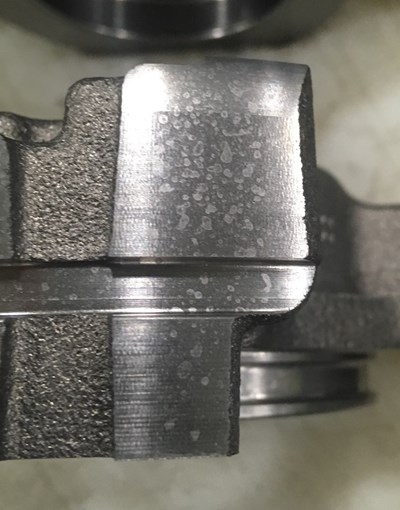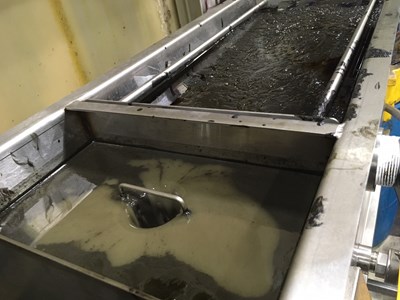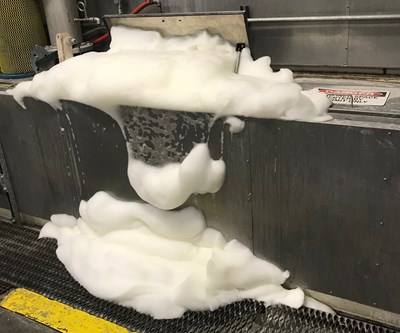Maximizing Cleaning and Rust Preventive Programs
Properly managed and controlled chemistry applied to the correctly designed aqueous parts washer is a formula for successful cleaning and corrosion resistance.
Aqueous cleaning programs are an integral part of a manufacturing process, and properly designed can yield environmentally sustainable solutions. Incomplete removal of soils can compromise subsequent operations and quality performance. With the proper design and operation management, aqueous parts washers can remove all surface debris while delivering the desired corrosion resistance. An effective washer program provides cost-effective, consistent and reliable performance at a maximum output. These benefits can be obtained when the system is properly designed, the right chemistry is selected, and the entire process is properly controlled.
System Design 411
Many options exist with parts washer designs. Typically, production rates and part configurations will dictate the type of washer selected. Spray washers allow for the shortest contact times to achieve cleaning objectives because of the added benefit of impingement. The right spray nozzles, properly aligned and maintained, are essential. However, cleaning cannot take place without adequate contact on the part, so components with recessed or internal areas may require an immersion process or a combination of both spray and immersion. “Action” of the cleaning solution is essential for effective cleaning and can be optimized in an immersion process with agitation. The addition of eductors to an immersion bath to provide turbulence can significantly improve the ability to remove soil. The inclusion of ultrasonics is an effective way to enhance action in the cleaning process. High production part washing applications require effective material transfer, often with a belt or a conveyor, to quickly process parts through the system.

Single-stage washers must be able to remove and manage the soils, while also providing rust protection. The combination of soil loading and water quality can contribute to residues on the parts being processed.
Many parts washing programs are comprised of a single stage of chemistry. They can be effective, but you must account for the pressure that is put on the single-stage washer. Without a rinse, everything in the cleaning solution will dry on the surface of the parts. This includes cleaning agents, rust preventives, water elements and all the types of soils being removed from the parts (at least until those soils are removed from the bath if a soil removal process is in use). Heavily soiled baths, or baths with excessive hardness, can contribute to spotting or even failed cleanliness tests. Single-stage washers must be monitored more closely, and typically recharged more frequently to assure reliable and consistent performance.
With two-stage washers, using the same chemistry compound in both stages is highly recommended over selecting two different products. Stage-one chemistry will carry over and quickly build up in stage two, compromising your ability to measure and control the stage-two chemistry. The chemistry in stage one will remove most of the soils, while stage two stays relatively clean. This improves the overall cleaning and dramatically improves the corrosion protection when a cleaner RP is used. Once saturated with soils, the stage-one solution can be discarded and the solution from stage two can be transferred to stage one. Then, fresh water and chemistry can be placed back in the stage-two bath, minimizing waste and improving economics.
When three or more stages are available, it is recommended to focus only on cleaning in stage one. It’s critical to select an effective product for stage one that is designed to clean the substrates completely and manage the soils effectively, and then rinse thoroughly in stage two. This will allow for the selection of a final stage chemistry that will provide optimum corrosion protection. The key is a functioning rinse in stage two, ideally overflowed on demand (based on conductivity measurements) and recharged routinely.
Chemistry’s Dirty Secrets
Aqueous cleaners can be formulated for all types of soils. Alkaline cleaners are ideal for organic soils, such as mill oil, coolant, stamping fluid and rust preventives. Inorganic soils such as oxides, scales (including laser cutting or weld scale) or corrosion are often removed with acidic chemistry or customized neutral products. Removal of the soils from the parts is not enough; the program must be able to manage the soils, creating an environment where

Continuous removal of soils from the cleaning solution provides consistent performance and extended life of the solutions. A coalescing unit is ideal for removing oils.
the soils can be removed from the washer on a continuous basis. Filtration will remove particulates, including metal chips, which otherwise left on the part surface will contribute to corrosion. Oil skimmers or coalescing units aid in removing oils, especially with a well-engineered cleaning chemistry. It is essential to ensure compatibility of the cleaning chemistry and the soils to avoid rapid deterioration of cleaning performance or secondary process issues such as excessive foam or cleaner consumption caused by soil reaction or neutralization. Understanding the nature of the soils to be removed is essential in selecting the proper cleaning fluid, and advanced testing in partnership with a chemical supplier will help with identifying the optimum process and parameters.

Aqueous solutions must be compatible with both the equipment in place and the soils being removed from the work. Failures can lead to problems such as severe foam.
Maintaining a consistent chemistry concentration in cleaning and rust preventive solutions is required for optimum performance. This is easily achieved with control technology, such as conductivity controllers. Controllers will measure the activity of the solution and trigger a feed pump, allowing for small, frequent additions of chemistry on an as needed basis, which is the best method of addition. These controllers can generate signals that can be captured by data acquisition systems allowing for SPC and historical trending. Routine titrations to confirm the actual concentration is still required, as soils and water hardness agents will also contribute to conductivity, causing the need to recalibrate the controller. The elimination of manual additions, either with the use of a chemical feed pump alone or with a controller not only reduces the wide swings in concentration, but also reduces the handling of the chemistry by the operators, which is a safety improvement.
All metals seek out their lowest energy state—it is a fundamental law of chemistry. Incorporating rust preventives will go a long way toward mitigating corrosion. Typically, parts washers will use synthetic rust preventives, often combined with cleaning agents in a single product. Be sure to select a product that provides sufficient protection, but does not compromise subsequent operations (welding or painting for example). Identify the ideal concentration where you have sufficient rust protection, but where the residual films do not compromise the program in any way.
Watering it Down to Composition
The composition of the water used in the aqueous cleaning (and rust prevention) baths can influence the performance and maintenance requirements. The impact of water quality on the cleaning system can result in foaming tendencies, sludge and scale formation and ability of the chemistry to inhibit corrosion. Calcium and magnesium salts—the typical hardness contributors—can react with soils, cleaning agents and even rust preventive additives, yielding insoluble compounds that will diminish the system performance. This is especially true with rust prevention programs, where the resulting precipitates may deposit on the components and damage the corrosion protection properties. Afflictive ions in the water, mainly chlorides and sulfates, will dramatically reduce corrosion protection. Heated tanks accelerate evaporation and concentrate the various salts in the cleaning solution, exasperating the problem as the tanks age. Regular evaluations of the process fluids for hardness, chlorides and sulfates, along with establishing upper limits, are key metrics to predict, in advance, the time to recharge an in-process cleaning and rust protection solution.
Softening systems will reduce the levels of calcium and magnesium in hard water, but these programs simply replace these cations with sodium and potassium. While this can drastically reduce sludge, scale and soap scum residue (reducing washer maintenance), high levels of sodium can contribute to paint failures through delamination). The ideal solution in areas of hard water is using deionized or reverse osmosis water.
Testing and Data
By nature, manufacturing programs are dynamic; changes will occur. A robust part washing program will tolerate variations, even with aged solutions. But significant changes, such as altering the coolant or stamping programs, changing substrate suppliers or increasing the line speed, must be proactively tested. Ideally, potential changes are communicated between departments well in advance. The key to success is running controlled tests, supported by the chemical supplier, to study the impact of the change and develop a plan to ensure consistent performance.
The ability to measure key parameters and correlate them with successful performance, or levels of concern, is an important aspect of the overall program. In a cleaning process, parameters such as concentration, temperature and pressure are essential, in addition to routine inspections of the spray patterns, cleanliness tests and soil load tests. Developing trends and associating them with both acceptable and unacceptable performance is key. Consider the use of humidity chambers or cast iron chip testing (ASTM D 4629) to confirm the health of the corrosion protection of the solutions.
Optimum control and proper maintenance of a parts washer are fundamental requirements for cleaning success. Documentation of relevant and applicable data allows for both validation of the process and set up for troubleshooting. Understanding the objectives and limitations of aqueous parts washers, along with monitoring the process, especially those factors that potentially degrade success, assures consistent and reliable performance, the foundations of a sustainable program.
About the Author
David M Gotoff
David M Gotoff is a product manager with Chemetall, the Surface Treatment global business unit of the Coatings division of BASF. Contact: 908-508-2258, chemetallna.com
Related Content
TTX Environmental Solves Customer Issue with Electro-Ceramic Desalination Wastewater Processing
Electroplating facility without access to a drainage system found a safe solution for wastewater treatment and reuse.
Read MoreClean Technology Lasers for Coating Adhesion
Laser cleaning systems remove corrosion, grease, residue and existing coatings from metal surfaces quickly, with less preparation and mess than traditional techniques.
Read MoreVacuum Degreaser Cleans Up a Messy Situation
By replacing its immersion parts washer with a vacuum degreasing system, this machine shop is much more efficient, saving the company money, man hours and the health of the operators.
Read MorePretreatment of Black Oxide
Having issues achieving a consistent color with the application of black oxide? Start by looking at your pretreatment. Connor Callais of Hubbard-Hall offers advice for troubleshooting your black oxide process.
Read MoreRead Next
Optimizing Aqueous Cleaning Requires Proper Design and Maintenance
A well designed and proactively managed aqueous washer system provides premium performance.
Read MoreChoosing the Right Aqueous Cleaning Operation
For most machining processes, water-based solutions can be applied using tailored technologies for specific applications.
Read MoreA ‘Clean’ Agenda Offers Unique Presentations in Chicago
The 2024 Parts Cleaning Conference, co-located with the International Manufacturing Technology Show, includes presentations by several speakers who are new to the conference and topics that have not been covered in past editions of this event.
Read More





















